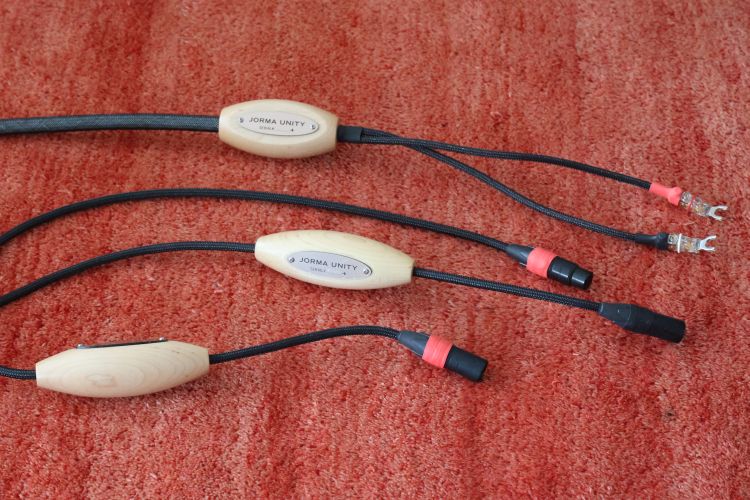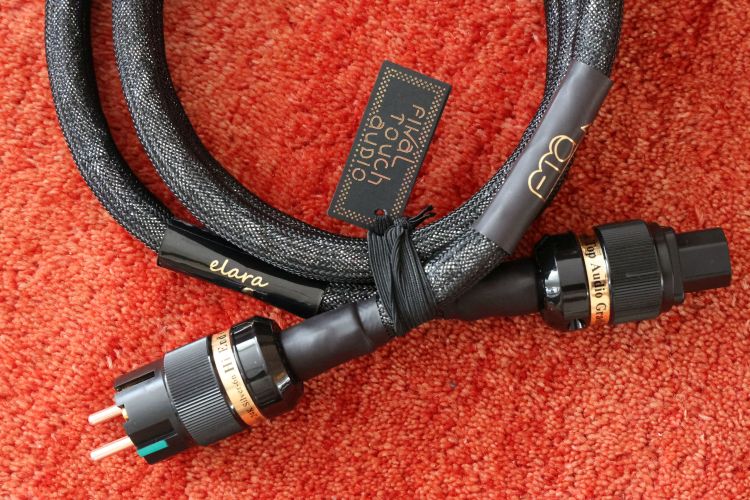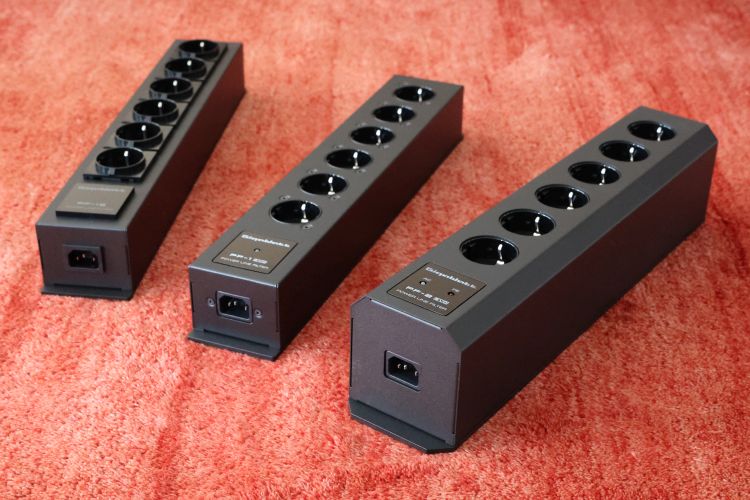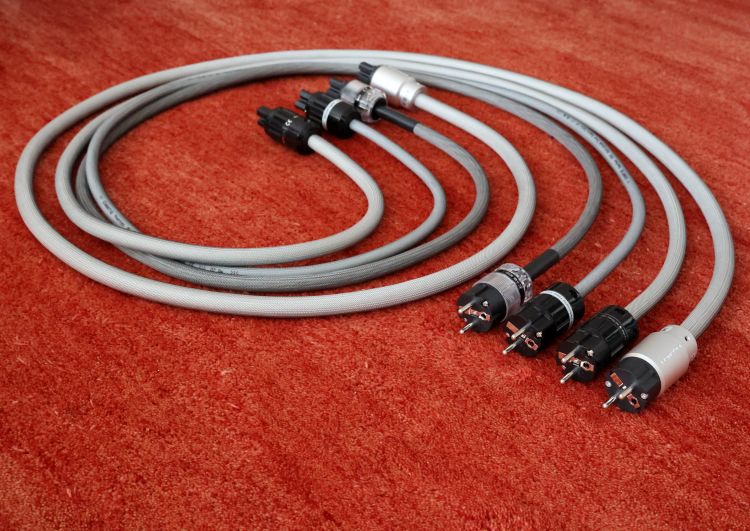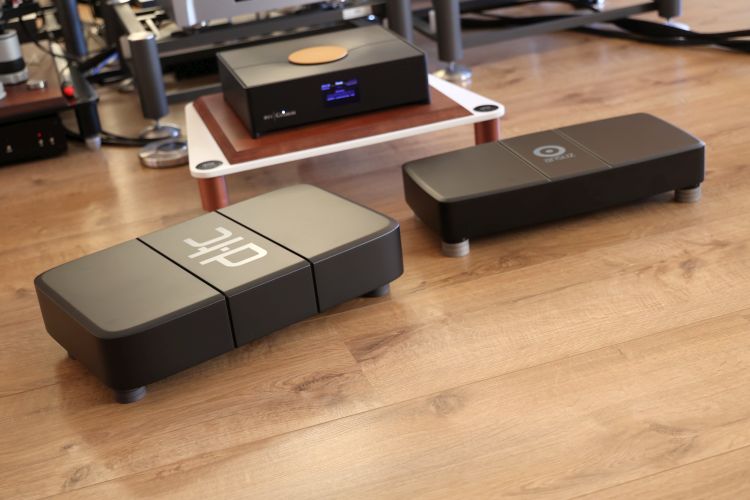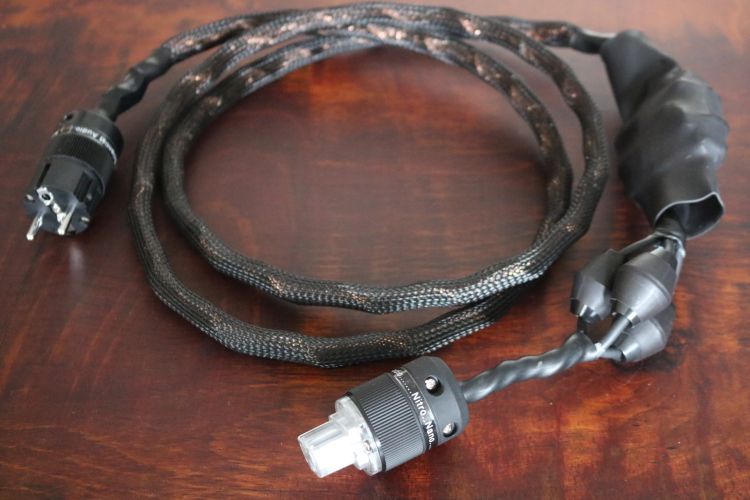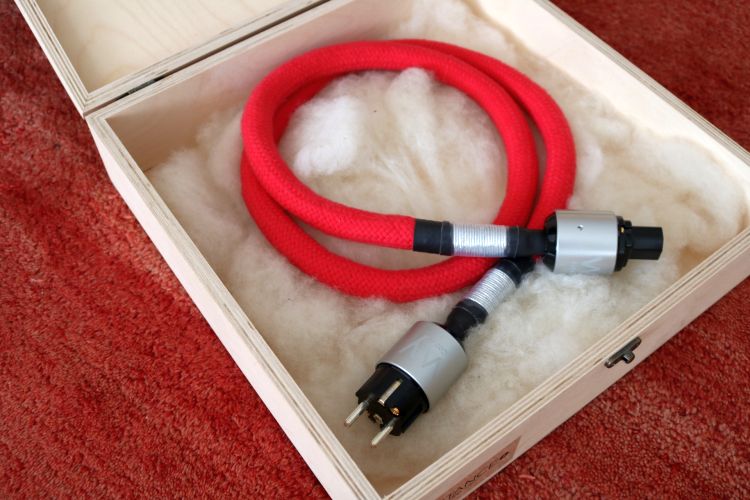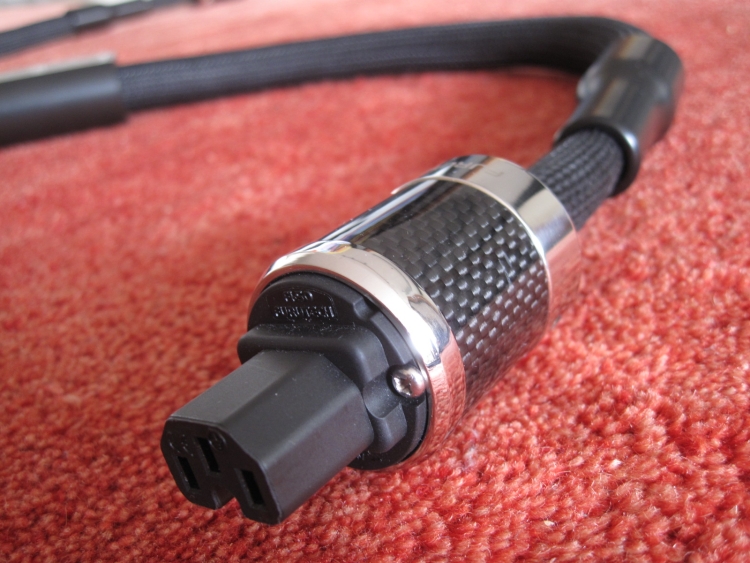
Mamba Audio is a relatively new specialist brand that makes exclusive analog, digital and powercables, as well as a beautiful power distributor/purifier
They are based in Spain, and make luxurious products aimed at the high end of the market. Tested here is their most universal powercable.
Review sample kindly supplied by Mamba Audio
Retail price: 3.125 euro
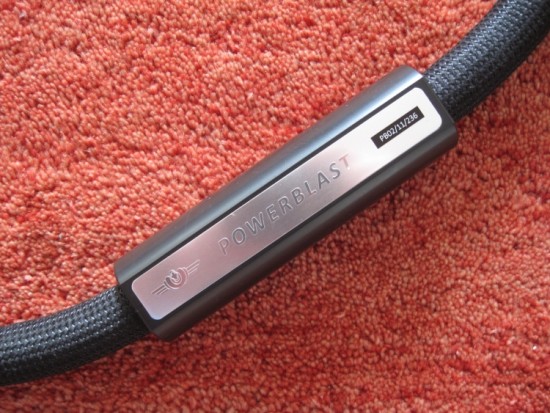
PowerBlast
The product in question is a powercable named PowerBlast. There is a whole range of cables and according to the manufacturer, the PowerBlast is the optimal solution in almost all components except the preamps, for which they make a special cable by the name of PowerFlow. There’s also a cable specially targeted for poweramps and distribution blocks called PowerFringe.
The manufacturer’s main goal with this product line is to eliminate parasitic electric fields and avoid electromagnetic fields, in an effort to, and I quote: “get the recorded message played properly respecting each frequency including all harmonics, and perfect synchronization of the energy for the components, getting the exact tempo of each instrument individually, to faithfully recreate the realistic and poignant emotion of listening to music”. Now that’s a mouthful! Judging from its flexibility I’d say that the conductors are not of the solid core kind, but likely fine litze. Apart from that there’s nothing I know, or can add to the cable’s physical properties.
Of no matter. I don’t generally pay much attention to design principles anyway and won’t do so here, rather I prefer to just connect and listen. And listening I did, plentiful! Not only in my own two setups, but also in my friend JW’s setup.
I do need to comment on the finish of this cable – it is quite simply superlative! This cable looks like a million bucks, and the details have been obviously given much care and attention. All its aspects are smoothly finished and nicely rounded, to produce a perfectly balanced look and feel of luxury and organic-ness, if that is even a word. The cable is comfortingly heavy but extremely supple, more so than any other cable I used before, so it is very easy to position even in tight spaces behind racks. A striking aspect of its design is the block in the middle. It’s not metal, and it’s not hollow. There are no secretive circuits inside and also no RF chokes as far as I can tell. Rather it is what seems to be solid nylon. The block can be positioned freely along the cable’s length, and just to avoid audible differences that might occur from changes in its position, I made sure to always use it in the same position, which was the middle of the cable.
Officially the PowerBlast is recommended for AMPS, CD, DAC, POWER AMPS, and I can only assume that with AMPS they mean integrated amps since it was specifically not designed for preamps. Be that as it may, I have of course tried this cable on all my components, because that’s just the kind of maverick that I am.
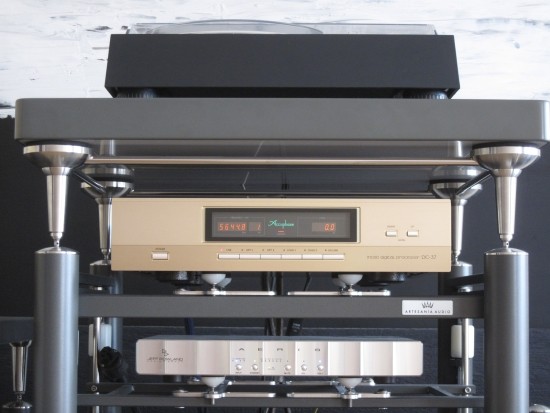
Accuphase DC-37 DAC
First candidate for the Mamba treatment was the Accuphase DC37 DAC that was over for review. The DC37 is a very refined and neutral DAC that leans toward the lean side of things: it is not very voluptuous in its presentation. I tried various cables with this DAC during its review, and my usual cables made it sound either dynamically constrained or overly thin. The best match found so far was with a Furutech Alpha 3 with Furutech gold connectors. Used this way it performed to a high standard and I certainly had respect for the Accuphase, but it didn’t stir my soul, so to say.
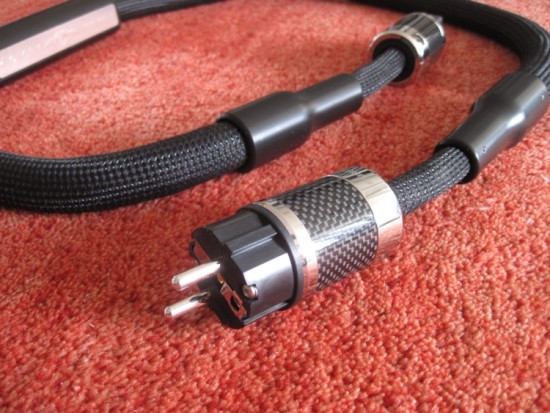
Substituting the Furutech cable for the Mamba Audio literally transformed this DAC. It changed my view of it from “very good” into “bloody marvelous”! I haven’t listened to very many Accuphase products, but so far I see a tendency for a need for some extra warmth or harmonic richness, for my taste at least. However one needs to be careful as adding warmth can quickly also diminish dynamic expression and speed. The interesting thing here was that the Mamba Audio PowerBlast managed to add harmonic richness to the Accuphase, without changing the dynamics. Perceived speed may have been slightly lower, but the DC-37 is plenty speedy, and has enough reserves so as not to start sounding slow in any way. But it isn’t only harmonic richness that the PowerBlast adds, it also expands the soundstage to room-filling proportions, in all directions. In doing so it may seem less sharply focused, but that’s more something of a technicality because another very strong attribute of the PowerBlast is its utterly natural way with human voices. Males and females alike in any music that I played have never sounded more natural and believable, or more sensuous. There’s absolutely no edge, no sharpness, no shoutyness, yet the expression is fully in tact. And there’s so much space around them. Importantly the voices are not carved out of cardboard, but possess body and substance, just like the real thing. The same goes for acoustic piano: a superbly difficult instrument to properly record, it easily starts to sound like a synthesized version of itself when played through less than capable equipment, but the Mamba Audio cable makes the most of this instrument. Percussive yet harmonically complete.
Finally it should be noted that the PowerBlast has to be THE most continuous sounding powercable I used so far: the decay after initial transients seems to go on forever, and perceived resolution seems to be of the “Retina” kind, which is to say that the particles of which the music is made (in digital at least) are so small that they are no longer visible, or rather, audible in this case. I don’t know which component I liked most at this stage: the DC37 or the Mamba Audio cable… well, for sure there is a special chemistry going on here.
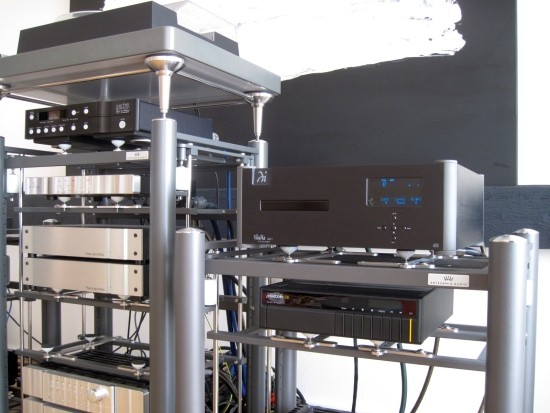
Wadia 861 CD Player
The Wadia is a picky beast: it won’t work well with most cables. No matter how massive it looks and how dynamic though it can be, it can easily start to sound constrained dynamically and temporally when it isn’t happy with a particular powercable. I find that it works well with a Furutech Alpha 3 and a Jorma Design Prime and even better with an NBS Black Label II. Neither of these cables sound dry per se, but for the Wadia’s needs, they could do with some extra fluidity. Partially because of this, switching from either the Jorma or the Furutech to the Mamba PowerBlast again makes for a transformation.
Wadias sound dry? Well certainly not with the Mamba Audio cable! The stage again is wide and deep and the overall sound is smooth, rich, fluid, relaxed… perhaps slightly too relaxed. It’s mostly the transients that seem slightly softened in their extremes and in combination with the Wadia’s intrinsic character make for a less dynamic impression. Perceived speed is also lower than with either the Jorma or Furutech, and with the 861 already not being a fast gun itself, with rhythmic music the combination is slightly too much. But with soul and smooth jazz, and I imagine with classical music as well, this rendition is perfectly at place. But what impresses mostly again is the natural sound of voices and piano, ever so seductive and sensuous. Plucked guitar however loses some of its attack and makes for a less involving listen. Overall I think the Mamba could still be considered a good partner with the Wadia 861 if the rest of the system wasn’t so smooth and relaxed already, but with my system it was slightly too much of a good thing.
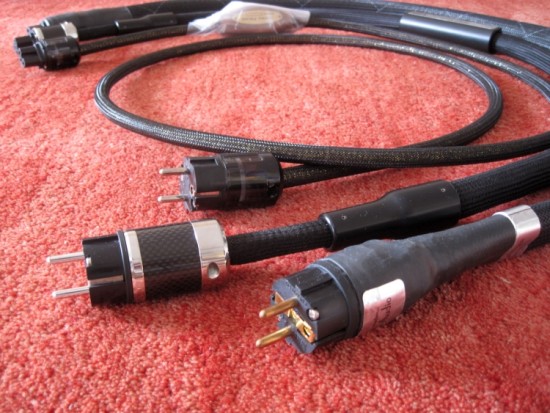
Above: Fusion Audio, Mamba Audio and Jorma Design – the Mamba Audio cable is easily the most handsome of the bunch
Meridian 506.24 CD Player
I know I know… this CD player costs less than the Mamba cable and the experiment serves no real purpose… but I couldn’t resist, the connector had to be inserted where ever I found an IEC inlet, and so the 3000+ euro cable fed the 2000 euro cuty CD player instead of the usual Furutech Alpha 3. But WOW was this ever an improvement! Just like the Accuphase and the Wadia, the little Meridian gained a massive amount of luxuriousness, soundstage width and creamy smooth fluidity. Importantly, the 506 did not lose any dynamics or speed and was entirely happy with the power that it was served. It definitely went up a class or two, but ultimately the humble 506 can do only so much and even with this spectacular cable, naturally, it was no match for the dearer players.
Jeff Rowland Aeris DAC
The Jeff Rowland Aeris is currently my favorite DAC: big, bold, dynamic yet smooth, rich and refined, if not perhaps the most refined DAC on the planet. The Accuphase does better in that aspect and so do some other DACs. Switcing the Aeris’s power cable from Harmonic Technology Pro ACII to Mamba Audio PowerBlast the most striking result is increased fluidity, but also enhanced perceived resolution. While very impressive, the overal result is similar to what I heard with the Wadia 861, which is to say that it wasn’t all for the better. The extra smoothness sure was very seductive, but I’m not sure if the Aeris needs it, for in the process, its dynamic expression was also slightly diminished and so I felt that PRaT (Pace, Rhythm & Timing) was reduced. In other words, the toe-tapping aspect was now less obvious, and this made for a more sensuous, but somewhat less exciting performance.
Wadia 121 DAC and Jeff Rowland 525 Class D power amp
I have to throw in another experiment of the “oh no you di-‘nt” kind… But because the result was so superb, I just had to include this. The 121 is an affordable, but decent DAC with an outboard switched power supply that is normally fed with a Harmonic Technology Pro ACII powercable. The latter is already romantic in nature, but substituting it for the Mamba Audio transformed the little Wadia from decent into very, very good. All the aforementioned attributes were present again, and just as with the Meridian CD player, there were absolutely no downsides with the Wadia 121. It should be noted that this particular comparison was done in my secondary setup in which I don’t use an analog preamp, but do temporarily use a class D poweramp in the shape of a Jeff Rowland 525. Class D in generic I feel is not so refined as typical class A/B and certainly not as harmonically rich as my bigger Rowland amps. The cool thing is that the Mamba Audio cable single handedly made up for the presences of the class D amp.
Used on the 525 power amp itself the effect was even larger, a bit too large I felt. While on the Wadia DAC it provided just the right amount of luxuriousness, with the 525 amp the Mamba Audio cable went a little overboard in its relaxed presentation, taking away some bite and dynamic expression.
Jeff Rowland Preamplifiers
Contradictory to manufacturer’s recommendations, I tried the PowerBlast on two preamps as well: my own Rowland Coherence II, and the Rowland Synergy IIi in my friend JW’s system. Connected to my Coherence II in place of the Harmonic Technology Pro ACII, the Mamba Audio worked splendidly, adding some extra richness, but without going overboard. Speed remained, as did the dynamics, and as expected, the treatment worked magic for voices and strings alike.
In JW’s system we used the Mamba Audio cable on the Wadia 861 and the Rowland Synergy IIi preamp. The Wadia behaved precisely the same as my Wadia, which is a mixture of good and less good. Good was that it definitely had the edge over the Fusion Audio Romance powercord in terms of fluidity, smoothness and richness. Voices had much more body and sounded more believable. Bass was also bigger and fuller. Less good were PRaT and transient attack – just like with my own Wadia 861.
Switching from the Wadia to the Synergy IIi preamp was another story, and here the fit was much better. There was still a noticeable diminishing of transient attack and speed, but in a more subtle manner, while the positive contributions were evident and impossible to ignore. Still, JW’s setup of course is tweaked to his usual components, and simply substituting the Cardas Clear Beyond powercable for the Mamba Audio PowerBlast offset things considerably. In fact these cables are rather different in presentation, and for the PowerBlast to fit in 100% perfectly, some changes would have to be made elsewhere in the system. I suspect that a Transparent Reference cable would need to be substituted with something more lively. Not having another brand interlinks or speaker cables at hand, we couldn’t further investigate this.
Conclusion
The Mamba Audio PowerBlast is a cable that is voiced toward relaxed and unforced musicality rather than technical neutrality, and I like that in any audio product. It’s definitely more fun to work with than a highly neutral product, but it’s also more difficult to implement into an existing system, especially when that system has been carefully tweaked. Don’t mistake this by thinking that the PowerBlast imposes a strong character on the music as it does not. In fact, I would call this a highly natural sounding cable and it made for the most beautiful renditions of human voices, piano and strings ever. It does tend to polarise things though, as for its superbly smooth and relaxed quality, sometimes it tends to take away some tension, speed or transient sharpness, and in an already smooth and relaxed sounding system, this can simply be too much of a good thing.
Compared to the Fusion Audio Romance the Mamba Audio sounds even richer and more luxurious, and with more body and substance. It makes voices and strings so much sexier and more real, and especially seductive when playing smooth jazz or soul. On the other hand, the Fusion Audio is lighter on its feet and faster, more transparent and more articulate, which helps when playing more dynamically expressive music. The Jorma Design Prime is in essence a supremely neutral cable, but still, I consider it to be on the other side of the scale, with a sound that is more “concrete” and more controlled, and less euphoric than either two cables.
I imagine that the Mamba Audio Powerblast would be the ideal antidote for an otherwise slightly clinical system, or for example a system that uses horn speakers such as AvantGarde which are highly dynamic but also potentially slightly edgy. Or a system that uses more conventional speakers, not ribbons such as in my case.
The Mamba Audio PowerBlast makes it possible for a system to gain tube-like attributes in terms of midrange liquidity and palpability, richness and pure conveyance of emotion, and for this aspect alone I think it is unique, but it needs to be implemented with care so as not to go overboard. It works wonders with the Accuphase DC-37 DAC, and I suspect, will do so with many more components, especially if they are somewhat on the lean/analytical side.
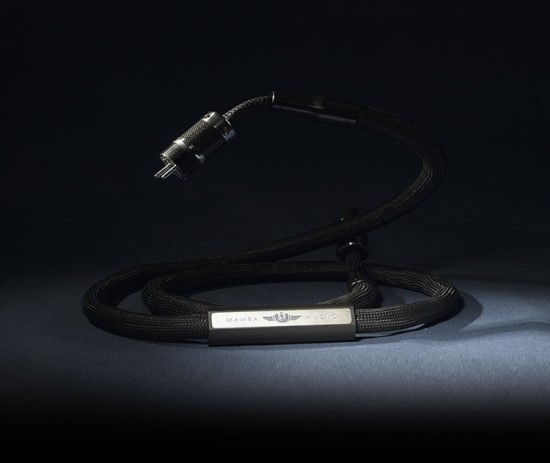
MAMBA AUDIO POWERBLAST
Intended purpose: AMPS, CD, DAC, POWER AMPS
Available lengths: 1,5m 2m 2,5m
Reviewed length: 1,5m
External Links
Factory Address:
Company: Mamba Audio SL
Street: Crisantem 66
City: Cunit
Postal Code: 43881
Country: España
Contact Person: Pepe Tuà
Phone: + 34 638 60 55 33
Inquiries: info@mambaudio.com
Manufacturer: mambaudio.com

